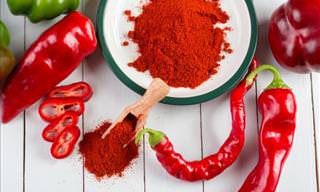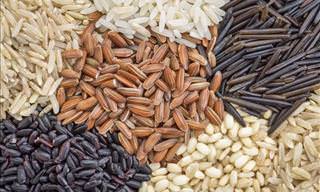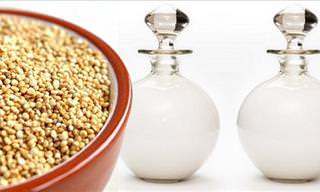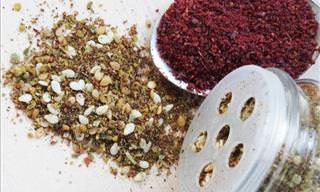With a sweet and sour taste and a red-purple hue, sumac is a great spice that adds a rich flavor to many dishes that people prepare in kitchens around the world. In addition to its ability to add flavor and color to various dishes, the sumac herb has many other advantages. Thanks to its high concentration of antioxidants, flavonoids, polyphenols, and other substances, it can help us cope with various diseases and improve our overall health. So, what is sumac, what is it made of, how does it affect our health, and how can we incorporate it into different dishes? You’ll learn all this and more in the article below.
Some information about sumac
Sumac is a well-known spice in Middle Eastern cuisine, which is made from berries from a bush of the same name. The use of this spice is particularly common in the Middle East, where it grows naturally. Its name originates from Syria and it translates to "red", due to the intense red color of the bush’s fruit. In order to produce the spice from the plant, its fruit is dried and crushed into a thin red-purple powder. The lemon-flavor spice is used in a variety of kitchens to prepare meat and chicken dishes, but also in a variety of spice blends for seasoning salads and similar dishes.
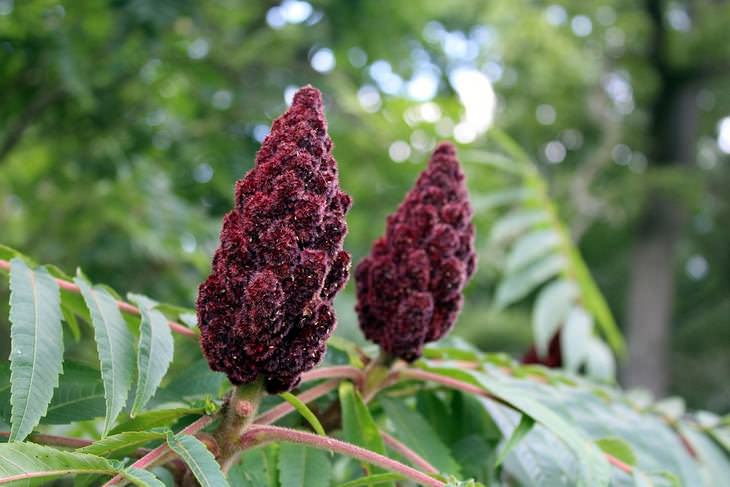
1. Balances blood sugar levels
High blood sugar levels can affect many aspects of our health. In the short term, this condition can cause symptoms of fatigue, headaches, frequent urination and increased thirst. In the long run, the consequences are more severe, such as nerve damage, kidney problems, and an impaired ability to quickly heal wounds. Studies have shown that sumac may help maintain normal blood sugar levels – in a study of 41 people with diabetes, some received 3 grams of sumac, and some received a placebo every day for three months. After the study period, the people who consumed sumac experienced a 13% decrease in blood sugar. In addition, sumac may help prevent insulin resistance - the hormone responsible for transporting sugar from the bloodstream to the tissues - that is, when blood sugar levels are high, insulin levels are affected accordingly and as a result, the body is resistant to its effects. According to the findings of a study published in 2014, sumac can be effective in lowering insulin levels in the body to prevent resistance to it and stabilize blood sugar levels.
2. Reduces cholesterol
High cholesterol is one of the biggest risk factors for heart disease. Cholesterol can accumulate in the arteries and cause them to contract and harden, which increases the effort of the heart muscles - causing difficulty in blood flow. New research has shown that sumac promotes heart function by lowering cholesterol, which also reduces the risk of heart disease. According to a study by the Tehran University of Medical Sciences in Iran, sumac is able to reduce cholesterol and triglycerides in rats with high cholesterol. In another study at the University of Sutcu-Imam in Turkey, similar findings were found showing that a combination of sumac and ginger caused a significant reduction in cholesterol levels in chickens.

3. Rich in antioxidants
Antioxidants are powerful compounds that help fight free radicals, all to prevent damage to cells and protect them from the development of chronic diseases. Some studies have suggested that antioxidants may reduce the risk of complicated diseases such as heart disease, diabetes, and cancer. In sumac, you can find a high number of antioxidants, ones that can help keep our bodies healthy. In fact, studies conducted at a university in India in 2015 show that sumac was effective in reducing the effects of diabetes in rats, mainly due to its high antioxidant content.
4. Reduces the chance of bone depletion
Bone loss, or osteoporosis, is a common condition characterized by weak bones and increased risk of fractures, caused by loss of bone mass. The risk of bone loss increases steadily with age, and the Centers for Disease Control and Prevention estimate that close to 25% of women over the age of 65 suffer from this phenomenon in the neck and lumbar spine. Although research into the possible effects of sumac on bone health is very limited, one study found some promising and encouraging results. A study conducted in 2015 showed that the administration of sumac extract to rats altered the balance of certain specific proteins involved in bone metabolism, resulting in decreased bone depletion.

5. Calms muscle aches
If you suffer from chronic muscle pain, sumac in your spice cabinet can help to treat the problem. In fact, a study conducted at the University of Mansoura in Egypt revealed that Sumac juice, which can be brewed from tanner’s sumac, can help reduce muscle pain during aerobic exercise in healthy adults. Thanks to the rich antioxidant content of sumac, it can also help reduce the risk of inflammation and thus provide additional relief from pain. Studies conducted in 2009 show that inflammation not only contributes to the development of various diseases, and plays a major role in the development of autoimmune disease - cell death and destruction of tissues in the body in different areas, but also contributes to the sense of strong pain.
6. Can help in the fight against cancer
If you search around the Internet for how sumac can help fight the development of cancer cells, you will find hundreds of related results. However, it is important to note that all the studies conducted on the relationship between sumac consumption and cancer are in laboratory conditions only and as of this time, have not yet been tested on humans. The good news is that studies on the relationship between sumac and colorectal cancer have suggested that treating cancer cells in this way significantly hinders their development. In addition, the sumac resin was found to inhibit angiogenesis - the formation of new blood vessels supplying food and oxygen to cancerous tumors, according to studies conducted at the University of Esfahan in Iran. In addition, you can find various studies proving that sumac intake can treat other cancers, ranging from breast cancer, leukemia, ovarian cancer to pancreatic cancer, and many others.

Things to keep in mind
Despite all the benefits of consuming sumac on our bodies, it is important to know some facts and warnings about its consumption:
- Allergic reactions - Since sumac comes from the same plant family of cashews and mangoes, you should consult a doctor if necessary before you ingest sumac, as those who are allergic to cashews and mangoes will probably suffer from similar symptoms after consuming sumac.
- Unwanted weight loss - Although most of us agree that this is actually an advantage, those of us who are underweight or have a problem maintaining normal body weight, we recommend that you avoid eating sumac daily. The reason for this is anti-lipase activity - an enzyme that speeds up the breakdown of oils and fats, which partially blocks the absorption of fat in the small intestine.
- Safety in pregnancy - Some herbs and spices are best avoided during pregnancy because some include uterine stimulants that may disrupt menstruation, which may increase the risk of miscarriage. The powerful antioxidant in it, quercetin, which has been found to help treat cancer, can lead to complications in pregnancy and childbirth. Therefore, it is recommended during pregnancy to avoid the consumption of sumac, at least until studies on the subject claim otherwise.
- Taking drugs - Statins to lower cholesterol, blood pressure medications, and diabetes treatments can have a bad effect on the body if consumed with a high amount of sumac. The result may be fatal as the drugs might not have the same effect on your body, so consult a doctor if you are taking any of these drugs.
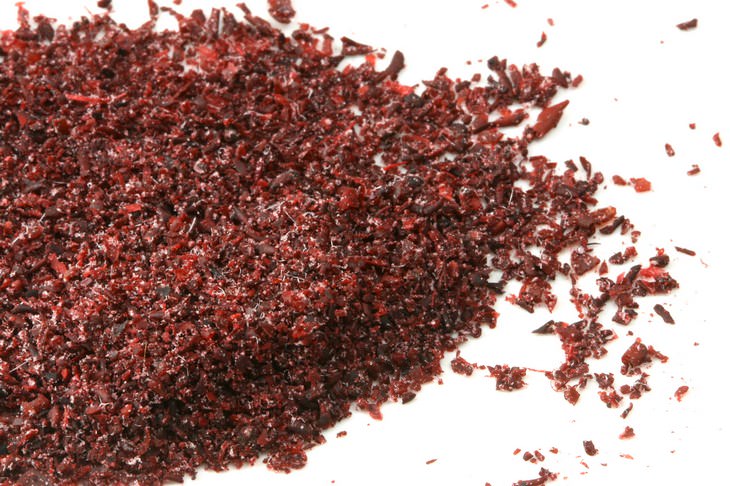
Two delicious recipes you should know
Roast chicken with sumac and pomegranate syrup
Ingredients: 8 chicken thighs, 3 tablespoons olive oil, 1 tablespoon sesame seeds
Ingredients for marinade: 2 tablespoons of sumac, 2 large crushed garlic cloves, 1½ teaspoons of hot chili, 1 tablespoon tomato paste, 1 tablespoon of pomegranate syrup, 1 teaspoon of salt.

Preparation:
- Mix all the marinade ingredients well, place your chicken in it and leave it covered in the refrigerator for an hour.
- Heat the oven to 400°F or 205°C, remove the chicken from the refrigerator, place it in a pan, pour olive oil over it and sprinkle with sesame seeds.
- Place the chicken in the oven for half an hour or until it turns golden.
Parsley salad with red onion and pomegranate seeds
Ingredients: 3 tablespoons olive oil, 1 tablespoon wine vinegar, 1 teaspoon pomegranate syrup or ½ teaspoon honey, 4 cups fresh parsley leaves, ¼ cup pomegranate seeds.

Preparation:
- In a large bowl, mix the onion, sugar and sumac, salt to your taste and set aside for half an hour.
- Then add olive oil, wine vinegar and pomegranate syrup, mix thoroughly and set aside for 5 minutes.
- Just before serving, add fresh parsley and pomegranate seeds, salt to taste, mix and serve.
image source: bonappetit, bbc
Related Articles:
The Top 10 Health Benefits of Cinnamon
You'll Be a Spice Pro in No Time After Seeing These
The Health Benefits of Curcumin
 Go to BabaMail
Go to BabaMail










